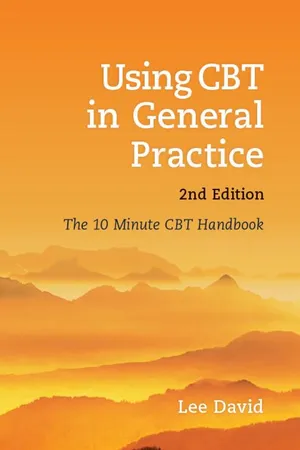
- 320 pages
- English
- ePUB (mobile friendly)
- Available on iOS & Android
About this book
How to use CBT within a typical 10 minute consultation Using CBT in General Practice, second edition provides GPs with an overview of the basic principles of CBT and shows how these principles can be applied within a typical 10 minute consultation. The book is written in a user-friendly, interactive and practical style and focuses on realistic ways to make CBT work by helping patients to make positive changes to their lives. Key features of this second edition include:
- case examples to highlight how the techniques can be applied in practice for patients with particular problems or clinical conditions, such as coping with negative thoughts
- problem-solving sections describe how to manage time constraints
- a new consultation model that can be used to implement CBT in general practice
- detailed overviews of the major clinical psychological conditions that can be treated using CBT, such as panic, low self-esteem, and insomnia.
Using CBT in General Practice uniquely provides the practical advice needed to implement CBT within the time constraints of a busy practice – it is therefore essential reading for all GPs, who must now offer CBT as a treatment option. As this is a practical manual and not just a book of theory, it will also appeal to other professionals involved in the management of patients with psychological problems such as practice nurses, health visitors, community psychiatric nurses, practice counsellors and palliative care doctors.
Frequently asked questions
- Essential is ideal for learners and professionals who enjoy exploring a wide range of subjects. Access the Essential Library with 800,000+ trusted titles and best-sellers across business, personal growth, and the humanities. Includes unlimited reading time and Standard Read Aloud voice.
- Complete: Perfect for advanced learners and researchers needing full, unrestricted access. Unlock 1.4M+ books across hundreds of subjects, including academic and specialized titles. The Complete Plan also includes advanced features like Premium Read Aloud and Research Assistant.
Please note we cannot support devices running on iOS 13 and Android 7 or earlier. Learn more about using the app.
Information
Chapter 12

Depression
Understanding depression
Cognitive-behavioural therapy for depression
A combined approach to depression for primary care
Focus of the intervention | Nature of the intervention |
Step 1 All known and suspected presentations of depression | Assessment, support, psycho-education, active monitoring and referral for further assessment and interventions |
Step 2 Persistent sub-threshold depressive symptoms; mild to moderate depression | Low-intensity psychological and psychosocial interventions, medication and referral for further assessment and interventions |
Step 3 Persistent sub-threshold depressive symptoms or mild to moderate depression with inadequate response to initial interventions; moderate and severe depression | Medication, high-intensity psychological interventions, combined treatments, collaborative care and referral for further assessment and interventions |
Step 4 Severe and complex depression; risk to life; severe self-neglect | Medication, high-intensity psychological interventions, electroconvulsive therapy, crisis service, combined treatments, multiprofessional and inpatient care |
Understanding depression
Typical thoughts and thinking styles in depression
Table of contents
- Cover
- Half Title
- Title
- Copyright
- Contents
- Preface
- Introduction
- SECTION A – INTRODUCTION
- SECTION B – SKILLS
- SECTION C – CLINICAL APPLICATIONS
- References and further reading
- Training resources for health professionals
- Index